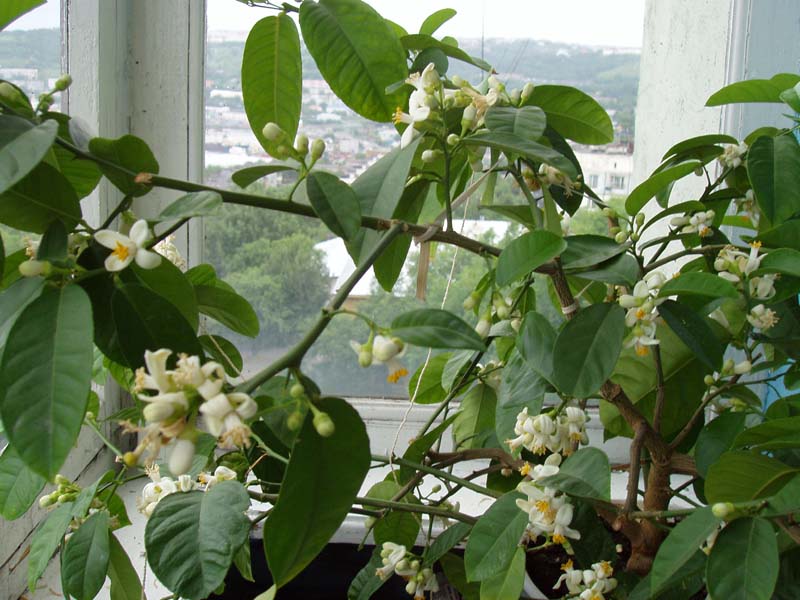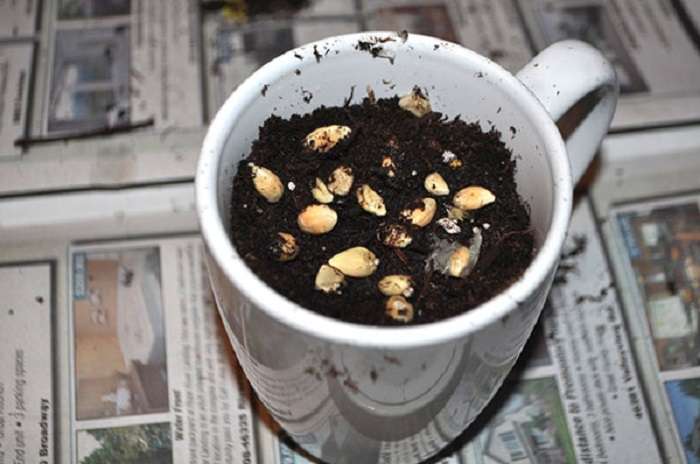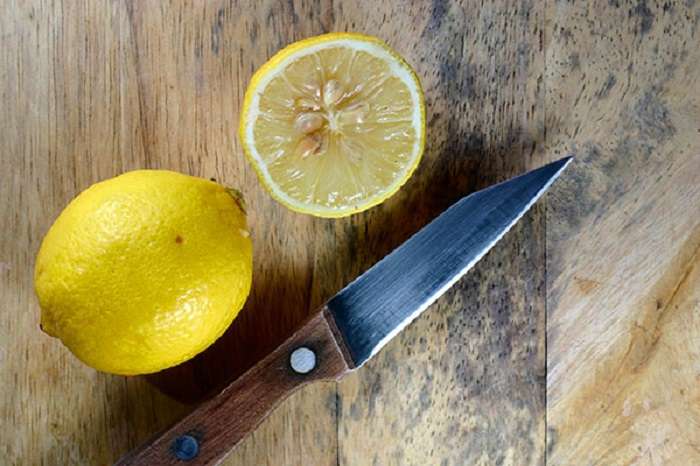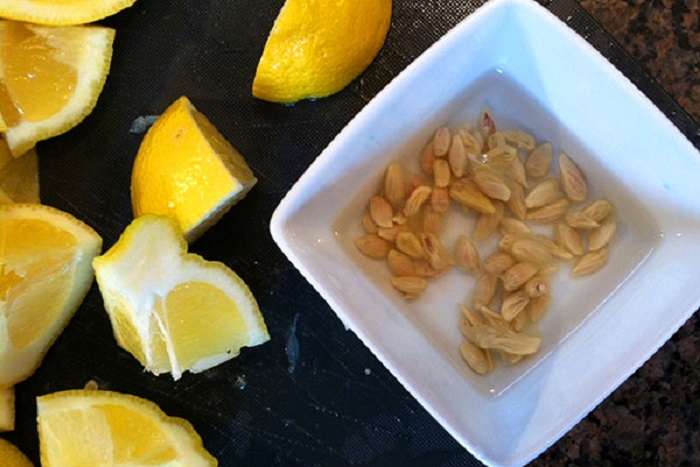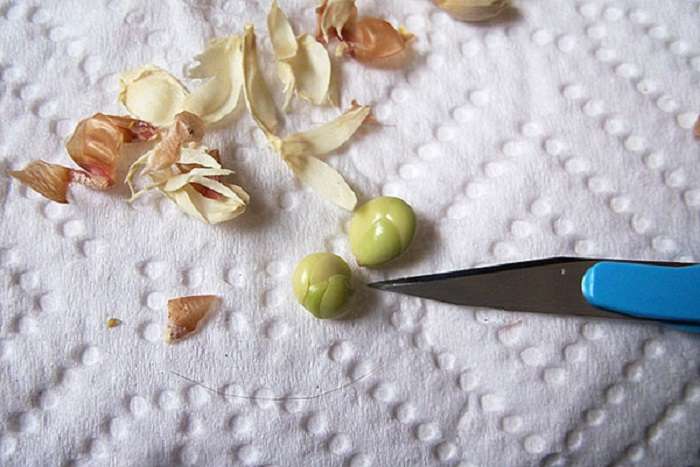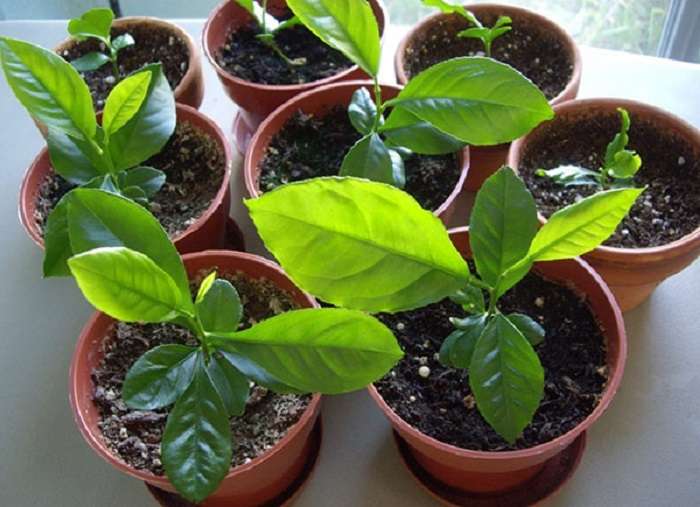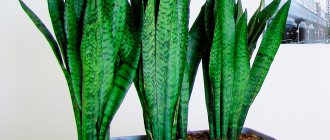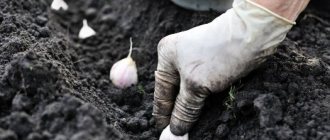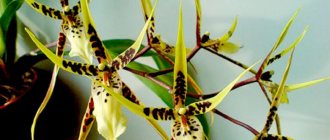Many types of citrus fruits grow well at home. But how to grow a lemon from a seed, which would not only decorate the room with leathery dark green foliage, but also bear fruit?
It is the lack of ovaries on grown plants that often disappoints home citrus growers. Indeed, in the best case, from the moment of planting to the flowering of an indoor lemon, it takes from 4 to 7 years. And yet, getting a lemon from a seed is an exciting and not a futile exercise. A strong tree can be used as a rootstock by grafting a stalk of a cultivated specimen on it, or push it to fruiting with competent care and crown shaping.
Preparation of planting material
To germinate lemon seeds, buy a fruit. Almost every fruit contains seeds. When choosing a lemon, pay attention to its appearance: the fruit should be ripe, yellow. It should be free of rot and mechanical damage.
The seedling is germinated from the largest seeds. Their germination and survival rate is almost 100%. The seed is planted wet: it does not germinate when dried.
To force the seed to germinate, it is treated with any biostimulant: root, heteroauxin or epin. The solution is prepared according to the instructions. Lemon seeds are soaked for 24 hours before planting.
Fertilization
The lemon tree is a highly productive citrus and therefore highly nutritious. Preparing the soil before planting is paramount, and good fruiting will require consistent feeding throughout the crop. Fertilizers must be applied to wet soil. During the growing season, a special citrus fertilizer is applied every 15 days or so to improve fruiting.
When the plant is on the street, it is recommended to feed it with organic fertilizer (bird droppings, slurry), having previously dissolved it in water.
Landing features
It is necessary to plant seeds in the ground to a depth of 2 cm. To successfully grow a lemon from a stone at home, 1-2 dozen seeds are planted at once. The strongest and most suitable for further cultivation are selected from the germinated seedlings. In addition, not all seedlings will be able to tolerate the grafting procedure.
After planting a lemon seed, the ground is irrigated with a spray bottle and covered with cut plastic bottles or transparent film. This makes it possible to further check whether the seeds have sprouted or not, without removing the shelter.
To grow a lemon from a seed at home, you will need to provide not only good greenhouse conditions, but also a stable temperature regime within 18-20 ° C with moderate air humidity of 40-50%. For this, the planting is placed on the windowsill, they are shaded at lunchtime.
Care for seedlings before germination consists in regular watering (irrigation from a spray bottle), airing and providing bright diffused lighting. A special role is given to watering. The sprouts should not be sprayed too often, otherwise they will rot. Moistening passes after the topsoil is completely dry.
Method 2
Use a thin wire to pinch the stem near the ground. (Wrap the wire around the stem quite tightly. Tighten it tighter as well.)

This is done in order to make it difficult for the juices to move upward.The most important thing here is not to overdo it, otherwise your "citrus fruit" may die. You can leave the plant in this form for no more than a month, because further it is dangerous. Further, the wire must be removed. While the stem is tightened, special substances accumulate in the roots that are responsible for reproduction. Often after this procedure, the lemon begins to bear fruit.
Growing features
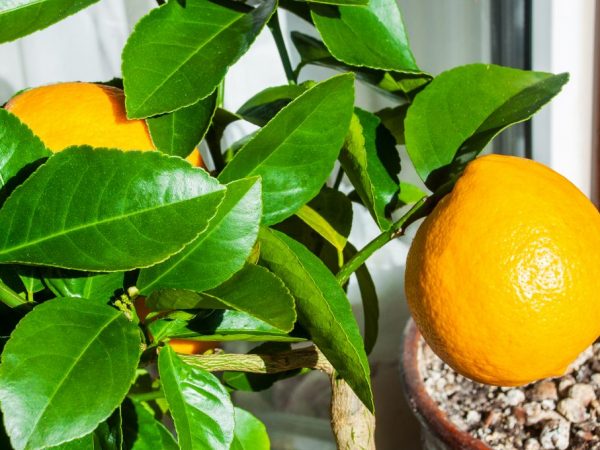

Take good care of your plant
Instructions for growing lemon from seed:
- After the seedlings break through the ground, they are in no hurry to open them. Under a plastic cover, the sprouts are kept until they have 2 pairs of leaves.
- Seedlings planted in a pot are gradually accustomed to room air, daily increasing the time spent in the room without shelter.
- Every day, plantings are sprayed from a spray bottle and placed in a well-lit place without direct sunlight.
Transfer
It is time to transplant sprouts accustomed to indoor air with 1-2 pairs of leaves into pots. The strongest plants with a thick stem are chosen for transplantation. The sprouts are transplanted into clay pots. In such a container, they feel comfortable and fully develop.
The subsequent transplantation into new pots is carried out as the tree and its root system grow. Before replanting the sprouts, the containers are soaked in water for 1-2 hours. A drainage layer (1 cm) of pebbles, expanded clay or broken shards is laid at the bottom of the pot. Then the soil is laid to the top from the same mixture as when planting seeds.
For a while, until the indoor lemon releases new leaves, it is covered with a transparent film or half of a plastic bottle. Before sheltering, the sprouts are irrigated from a spray bottle.
The rules for choosing quality sprouts:
- They look at the density of the crown. In high-quality seedlings, it contains at least 3-4 pairs of leaves. Choose a seedling with the smallest buds.
- A young plant should not have many thorns.
- Pay attention to the quality of the fastening of the leaves: they hold firmly and do not fall off at the slightest touch.
- Thin sprouts with bad leaves are discarded.
When to replant lemon seedlings?
The first transplant or pick is carried out when the seedlings produce a third true leaf. For this, cups of 50-70 ml or 100 ml are taken (it all depends on the size of the seedlings). Seedlings are carefully removed along with the soil. It is very important to leave soil around the root system of the young flower. At the same time, without violating the integrity of the earthen coma, the roots are pinched. The main root is cut with a sharp knife to 1/3 of its length. If this is not done, the main root will continue to grow, twisting into rings at the bottom of the pot.
You can pinch the roots as follows: in a glass where young seedlings grow, a knife is thrust directly into the ground to a depth of about 8 cm, and there they are carried out. This will make the plant easier to transplant. At the same time, the lateral roots are not injured and the integrity of the earthen coma around the shoot is not disturbed.
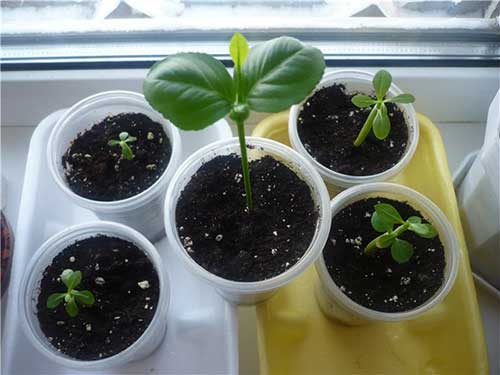

Lemon transplant soil is chosen special for citrus fruits. The first feeding can be carried out 1 month after the pick. All citrus fruits grow in stages. The stages of rapid growth are followed by a complete cessation of growth. That is why novice growers should not worry about their lemons if they suddenly stopped growing after intensive growth of green mass.
How to care for
It will be possible to grow a lemon from a seed at home only if the tree is properly cared for.
Illumination
Illumination is a prerequisite that ensures the full development of the crown and good health for the lemon. In summer, the plant has enough normal daylight. In early spring and autumn, the lemon tree is artificially illuminated for 10-12 hours a day.
Temperature
In the process of growing, this tropical plant will require a stable temperature regime in the range of 25-27 ° C. Staying under the sun is excluded, otherwise the tender young tree will receive serious burns and die.
Humidity
Caring for seedlings of lemon pits involves ensuring the required level of humidity at home. This indicator for him should be in the range of 70-80%.
Indoor lemon responds well to daily irrigation of the crown, periodic shower with warm water - at least 2 times a month.
Transfer
This plant should be repotted frequently. This procedure promotes better development of the root system and stimulates the growth of the aerial part. Planting of adult plants in a new container of a larger size (5-6 cm in diameter larger than the previous one) is carried out at least once every 2 years, for young specimens, transplantation is carried out annually. The best time for this procedure is summer. If it becomes necessary to transplant indoor lemon in winter, this is done in February.
Top dressing
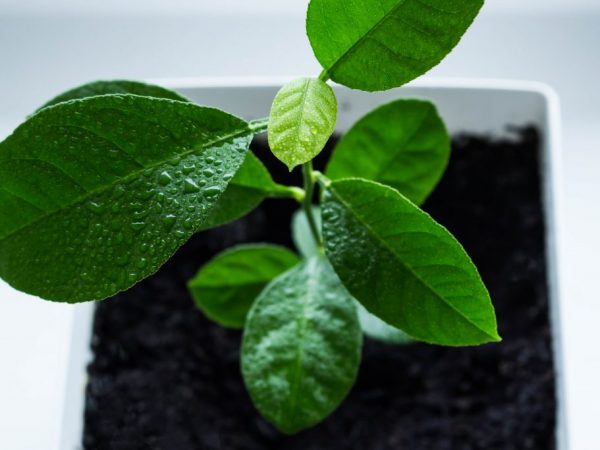

The plant needs fertilization
Between February and September nutrients are applied to lemons. This is the most active period for the growth of tropical plants. Biological and mineral fertilizers are used as top dressings, which are used alternately. Top dressing is applied in liquid form under the root. The main thing is not to overfeed the lemon, so they try to carry it out according to the instructions on the package.
Crown formation
The main care for lemons involves a crown formation procedure. To grow a tree with a lush crown, the apical shoot is cut, thus stimulating the development of lateral branches. The procedure is carried out in the first year of life of indoor lemons.
In order for the crown to be symmetrical, it is regularly rotated around its axis by a quarter. In the future, this technique has a positive effect on the quality and quantity of fruits.
Bloom
If a young lemon began to bloom quickly - already in the first year of life - all the buds are removed, because all the plant's strength will go to flowering, and it will simply wither away. Flowering near a tree is allowed when there are at least 7 pairs of leaves per flower bud.
Which variety is right for the home?
Planting a lemon starts with choosing a variety. For beginner citrus growers, varieties such as: lemon Panderoza, Meyer and Pavlovsky will be suitable. All varieties The variety are remontant and parthenocarpic, that is, they are able to bloom and bear fruit all year round without pollination. Let's consider each separately.


Lemon Panderoza is a mid-season variety, the tree of which has a spreading crown and short thick shoots. Leaves are oval, 15 by 8 cm in size. When flowering, it throws out clusters with large flowers, the petals of which have an oblong shape. The fruits weigh 500 g, are large and obovate with light green flesh and many seeds. The skin is thick and rough.
Meyer's lemon (Chinese dwarf) - suitable for small apartments. He is the shortest of his kind. It has small leaves, dark green in color. The buds and flowers are usually in clusters. Fruits are round, medium-sized 100–150 g, juicy, not too sour and with a pleasant aftertaste. They are distinguished by a thin skin of bright yellow color and a smooth surface. The yield is high. Such a tree will begin to bear fruit in 2 years. In the summer it puts up with the heat, but in the winter it needs to be supplemented and sprayed with the crown.
Pavlovsky lemon is a popular selection, which is more than 150 years old, one of the most hardy to adverse conditions. Leaves are oval, obovate with a sharp tip. Fruits are relatively large, oval, without seeds, with a thin, fragrant rind. Flower up to 3 cm in diameter. It tolerates low light well, withstands dry indoor air.
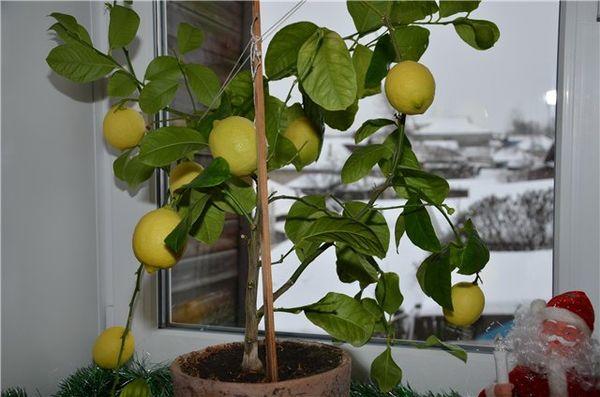

Fruiting
With proper care of the plant, it is possible to grow a lemon from a store-bought seed that will bear fruit.True, the plant will give its first fruits at home no earlier than after 8-10 years.
To stimulate an earlier fruiting process, lemons are grafted. Vaccinations are made to other citrus fruits: tangerine or grapefruit. For vaccinations to give a positive result, they are carried out in the spring or summer.
There is another way for a lemon to bear fruit - pinching. In addition, after such manipulation, the lateral shoots (of the second order) are pinched to a length of 18 cm. The procedure is repeated until the branches of the 4th order appear. The first flower buds are formed on them, and then the fruits.
Lemon tree in nature
The lemon tree is a resident of hot countries: India, Greece, Cyprus, Turkey. It is a hybrid representing the genus Citrus. Once upon a time, lemon originated from such a fruit as citron. In nature, the tree grows up to 6 meters in height. Bears fruit once a year. In some countries with very warm climates, lemon bears fruit twice a year.
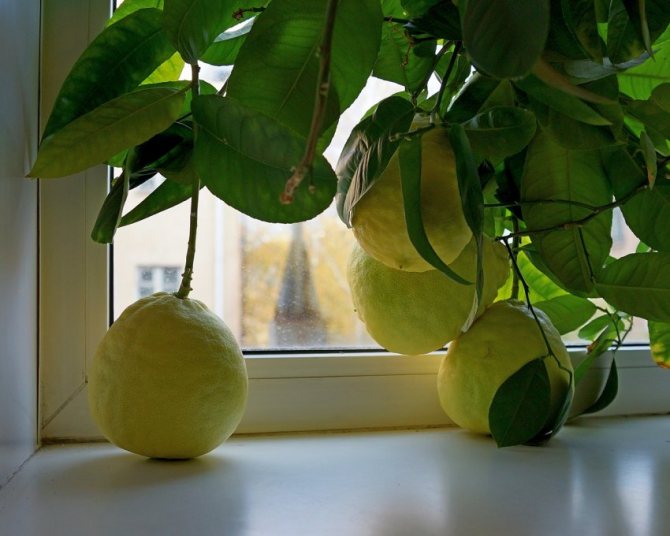

Lemon in a city apartment
The tree is compact, evergreen. Leaves do not fall off at the same time, but are gradually replaced by new ones. The peculiarity of the plant is in its leaf plates. They have a lemon scent, just like the fruit.
The plant is powerful, unpretentious. Lemongrass can grow even in the most unsuitable places for this. For example, next to the beach, where the soil is poor, and the sun is baking.
Additional Information! In Russia, lemon plantations can be found on the Black Sea coast, in the gardens of the Caucasus. For cultivation, special techniques are used. They consist in digging trenches that protect the rhizomes from low temperatures.
Helpful hints
Recommendations on how to care for lemon:
- Use only warm, settled water for irrigation. Rainwater and melt water at room temperature are also suitable.
- In the first months of life, do not feed the plant, otherwise it will burn out and dry out.
- Avoid drafts and sudden changes in temperature, otherwise the tree will wither, turn yellow and shed the foliage.
- Reduce watering frequency towards fall. Moisten as the top layer of the earth dries out.
- Remove all deformed and damaged ones to prevent decay and disease infestation. Yellowed and dried leaves are also subject to removal.
Bloom
Depending on the variety, the color of the flowers can be white, pink or red. To get fruit, it is important to properly care for the plant during flowering and follow a number of rules:
- during the flowering phase, do not rearrange the lemon tree to another place;
- pollinate the plant yourself (with a cotton swab, carefully transfer the pollen to the stamens);
- remove excess flowers in a timely manner.
At the first flowering, you need to remove half of the buds. It is best when there are 15 to 25 leaves per fruit.
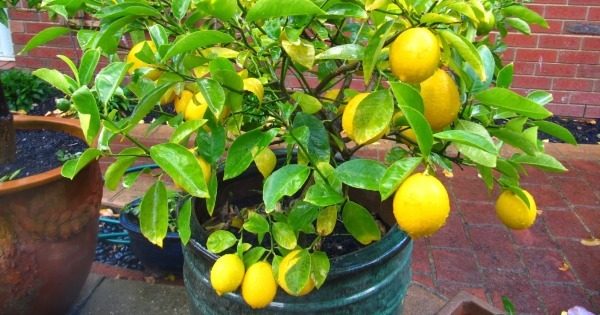

From the moment the ovary appears until the fruit is fully ripe, it can take more than 9 months.
Plant feeding
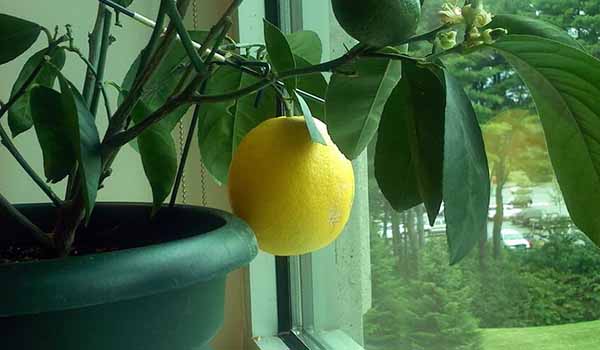

Many are wondering if lemon will bear fruit without fertilization. This plant reacts sharply to excess and deficiency of any elements. Therefore, to make fertilizer should be done carefully.
The break between dressings is from 10 to 15 days. When a tree enters a phase of active growth, it is useful alternate mineral and organic fertilizers.
Of the minerals it is best to use: ammonium nitrate (5 g), potassium salt (2 g). Superphosphate (5 g) is stirred in hot water and additionally boiled for half an hour in an enamel container.
Sometimes magnesium sulfate (1 g) is added. Before the start of the growth of shoots, you can spray the tree iron sulfate (2 g). However, it should not fall on young leaves and growing shoots. This can cause burns. The dosages given in brackets are calculated per liter of water!
The most useful organics are: infusions of horse manure (1: 8) or cow dung (1:10)... They should be fermented for at least two weeks.Poultry droppings need to be bred especially carefully. One part of the fertilizer goes from 15 to 20 parts of water.
Note! The fertilizer should be 3-5 degrees warmer than the irrigation water. It is impossible to make fertilizing with phosphorus and nitrogen at the same time. Nitrogen is used only during active vegetation, and phosphorus is useful for buds and flowers.
Will there be fruit?
If you plant a room lemon with seeds, then it will begin to bear fruit for 7 - 9 years, if by cuttings - for 3 - 4 years, by cutting - after 1-2 years.
To speed up fruiting, there are the following methods:
- Cleavage... Make an incision on the seedling and attach a stalk from a fruiting tree, wrap it with electrical tape, cover it with plastic wrap on top, as it grafts, remove the film.
- Budding.Cut the seedling to 10 cm and graft a fruiting stalk to it. Both methods significantly speed up fruiting. The plant may not bloom if the cutting was taken from a tree that has not previously produced fruit.
Lemon fruits have both beneficial and medicinal and harmful properties. You can read about them in our article.
Failure to comply with the temperature regime, insufficient lighting, irregular pruning and disease damage, the plant will not bear fruit.
You can make lemon bloom by cross-pollination during the flowering period within the same cultivar.
Popular types of indoor lemon


Meyer's lemon
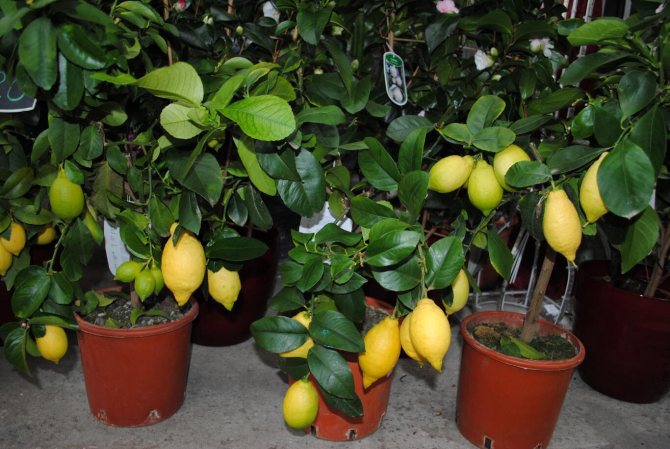

Lemon Pavlovsky


Lemon Lunardio


Ponderosa lemon


Lemon Jubilee
- Meyer's lemon
- Lemon Pavlovsky
- Lemon Lunardio
- Ponderosa lemon
- Lemon Jubilee
Watering
Watering is all the more important, since a lemon tree dries out in pots much faster than if it were in the ground.
In summer, frequent watering is required, while in winter, you should reduce the amount of watering.
Watering should be done as soon as the soil dries up, without flooding the pot, so that the earth does not sour from excess moisture, but does not dry out.
The water temperature should be 2-3 degrees higher than the air temperature. In summer, the plant must be sprayed with water from a spray bottle at least 3-5 times a week, in winter - 2-3 times; wash and wipe the leaves on both sides with a wet cloth at least once a week.
How to plant a lemon with a seed?
It is better to give preference to seeds from the largest and most juicy fruits. Lemons grown and ripened under artificial conditions may not sprout. Or, after a lapse of time, it does not give fruit. You cannot store them, because they quickly lose their germination.
So, we proceed to the landing:
- Sow fresh lemon seeds in a pot with moist soil.
- We periodically moisten the soil, while avoiding the accumulation of water, otherwise the bone will rot.
- Soon the seeds will hatch, and small plants will appear.
- It would be wiser to plant several seeds in order to select the strongest sprouts from the obtained sprouts after 2-3 months, or to plant them in different containers and get a lemon garden at home.
- When transplanting, try not to touch the earthy clod on the roots.
- To provide seedlings with normal conditions, place the pots closer to the south or west side, but control that the sunlight is diffused, direct rays can destroy the plant.
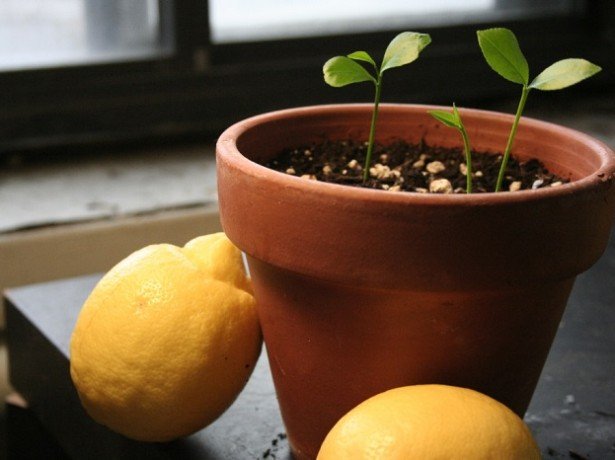

Photo of pitted lemon
There is an opinion, and its validity has been proven by many experienced growers, that a lemon from a stone does not bear fruit. For this, the resulting tree, when it grows up, and its trunk reaches a thickness of 1 cm, must be grafted from a plant that has already borne fruit. At home, inoculation is successfully carried out using the budding method, that is, with an eye bud with a small piece of bark, in order to increase the chance of double budding.
What to do if citrus does not bear fruit
Before growing a lemon at home from a seed, it is important to determine the purpose of the tree. If you want to get a bountiful harvest, it will take effort. How to make indoor lemon bear fruit without grafting:
- compliance with the rules of care (regular watering, high humidity, a lot of lighting, regular feeding, transplanting and pruning);
- provide the tree with winter rest.
A proven method of stimulating growth is the "ringing" of the trunk. It is as follows:
- Tighten the tree trunk at the base with copper wire. The banding should gently squeeze, but not injure the bark.
- After 6-12 months, the ring is removed, the damaged bark is covered. This must be done carefully so as not to damage or break the barrel.
As a result of ringing on the damaged area, an influx of bark is formed. Further, the growth zone is stimulated. It is less traumatic than vaccination.
Selection and preparation of seeds
This step largely depends on how healthy and strong the tree will turn out to be. First of all, attention should be paid to the ripeness of the fruit, its integrity, the absence of deformation and signs of disease. Cut the washed lemon in half and select the seeds. For planting, leave those that are larger.


You need to prepare the bones immediately before starting work.
If they dry out, they will not germinate. Better to take a few of them, with a margin. Rinse under running water.
Advice. Treatment with biostimulants increases the chances of success. The planting material is soaked for 12-24 hours in a solution with the addition of Zircon, Epin-Extra (add 1 drop of the drug per 250 ml of water). The procedure improves bone immunity.
Beginners are interested in the correct germination of seeds. And this is not required. The treated achenes are immediately placed in the soil. There are 2 ways to prepare seeds:
- After soaking, without drying, they are planted in a prepared substrate. It is important to ensure that they do not dry out.
- To speed up the process of seed germination, the hard shell is removed from the seed with a sharp knife, and then transferred to the ground. But in this case, care is needed - there is a great risk of damage to the cotyledon.
Lemon transplant
The fact that it is time to transplant the lemon is evidenced by the roots sticking out of the drainage hole, but this is a case of extreme neglect. A planned transplant should be carried out as the tree grows, each next flower pot should be slightly larger than the previous one. There are circumstances of a forced transplant, for example, a pot may break or you will feel an unpleasant odor from the ground.
If the lemon does not grow well, it can be transplanted in the fall, although the optimal time is the end of February, until active growth begins, or the middle of summer.
- Carefully take out the plant, cut off the broken and damaged roots, and sprinkle them with crushed coal or Kornevin. It is not necessary to completely shake off the earth lump.
- Place a drain on the bottom of the pot and add some river sand. Above - a layer of soil.
- Cut off some of the branches to make it easier for the roots to feed the plant.
- Make a depression in the soil, set the lump so that the neck is just below the edge of the pot. If you need to raise, fill up the earth.
- Sprinkle earth in layers around the edges, making sure that the trunk is in the middle of the pot.
- Trample the soil with your hands so that no voids remain.
- Pour with settled water and loosen the soil a little.
Courting and Protecting: The Main Enemies of Citrus
Lemon gets sick if you do not follow the rules of care. If the tree is watered a little, it will dry out. If the soil in the pot is oversaturated with moisture, then yellow leaves will appear on the lemon, and this will be a sign that the roots of the tree are beginning to rot.
Also the appearance of yellow spots on the foliage, after which the leaves dry and fall off, indicate that the wood lacks iron.
Drying leaf ends say that the tree needs phosphorus. A lack of potassium and manganese leads to wrinkling of the leaves and falling off of the ovary.
Knowing how to grow a tree is not enough; it is important to be able to care for it.If a pest is noticed on the plant, it is necessary to figure out what kind of parasite it is and urgently take measures to combat it.
Below are some common parasites that can attack a home-grown lemon:
- Mealybugs, popularly known as "hairy lice" - on a tree they can be recognized by a white bloom. They prefer dry conditions, they are afraid of moisture. A good prevention of this parasite is to regularly rinse all the lemon leaves.
- Shield - small shiny droplets appear on the leaves, sticky to the touch. Leaves dry and fall off. Soapy or garlic water is used against this pest. Soap water is prepared as follows: 2 tablespoons of liquid soap are dissolved in 1 liter of water. The resulting mixture is treated with the affected tree. An hour after the procedure, they are washed under the shower. It is desirable to repeat the treatment after 2 days.
- Spider mite - small, light dots on the sheet plate. The leaves are curling up. A cobweb is visualized on their back. If this parasite is found on the lemon, it is necessary to treat the tree with sulfur. For prevention purposes, the lemon is washed under running water, paying more attention to the underside of the leaf plates of the tree. Spraying with a solution of water and laundry soap helps to fight the mite well.
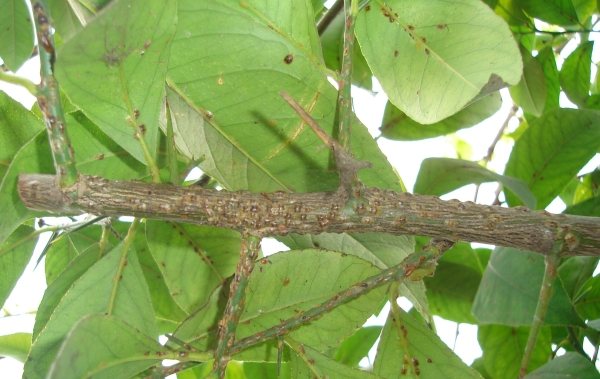

Common parasites that can attack home-grown lemon: mealybugs, scale insects, spider mites
Clay pot
Clay pots have been used to grow lemons since the beginning of home cultivation. Gardeners say that clay pots are the most suitable pot for growing citrus plants. Moreover, the assortment of clay containers is varied in shape, degree of firing and ornaments, applied by hand or by stamping.
Why is clay better? Yes, because clay is a permeable material - water is absorbed by the pores of the walls of clay pots and partially evaporates into the atmosphere, reducing the risk of decay of the root system of lemons due to waterlogging and stagnant water.
There is also the opposite effect, the walls of the clay pot, which have absorbed water during irrigation, give off moisture when the earthen clod dries. Thus, the clay pot serves as a kind of accumulator of moisture for plants - a sponge that absorbs excess and releases water in case of a lack.
Clay pots are heavy and therefore stable. For a plant growing in a clay pot, you can be calm - it will not topple over from the wind or from the push of a person who has touched the plant.
The disadvantages of clay pots are well studied, there are several of them:
- High evaporation rate moisture through the walls of the clay pot can supercool the earthen lump, which is harmful for indoor lemons, especially if the plant is in a draft.
- Excess salts and minerals are deposited on the inner walls of clay pots, which stimulates development of the root system near the walls, next to deposits of nutrients. A large number of roots at the walls can suffer from heat or cold, taking the temperature away from the walls.
- Roots grow together with the clay surface and are severely damaged when transplanting or transferring plants to another pot, and transplants must be done regularly.
- Clay pot wears out over time - the pores of the clay walls are clogged with hardness salts and small soil particles, the pot looks like clay, and holds water like a plastic one.
- Clay is a brittle material. A light blow to the pot is enough to split it into several pieces.
Preparing a clay pot for planting a lemon
You cannot plant lemons in new store-bought clay pots without first preparing the container.
To remove from the pores salts and gases formed during the firing of terracotta dishes, new clay pots are soaked in water and kept for several hours. The pores in the walls are filled with water, which displaces all unnecessary from them.
If the pot is not soaked, all unnecessary substances will move from the clay into an earthen lump, and you will be perplexed why the plant got sick, although the roots and substrate were disinfected.
Old pots should also be disinfected and the inner surfaces cleaned of salt deposits. Salt deposits can be removed with citric acid or vinegar. After disinfection and removal of salts, the inside of the pot is washed with laundry soap and rinsed with hot water.
By the way, clay pots with glazed walls do not differ from plastic dishes in terms of water permeability - the glaze does not allow water to pass through, turning clay into a kind of plastic.
You can grow lemons in white clay pots - chamotte, which are similar in characteristics to clay pots. Lemon roots, in white clay pots, are not afraid of temperature changes.
Preparatory activities
How to choose the right place?
Lemon is a subtropical plant and the climate of the apartment is ideal for him, pre-determine a place that is well lit, but without direct sunlight, possible drafts are undesirable.
The windowsill can be used while the plant is small, in winter you need to take care that drafts and cold glass do not damage the lemon, unfavorable conditions will lead to foliage falling off.
You do not need to unceremoniously turn the plant towards the light, you need to slowly, several centimeters at a time, rotate the plants around its axis, the lighting will change slowly, little by little, the plant will develop evenly from all sides, leaf fall due to a sharp change in lighting will not happen. They do the same with already large bushes and trees.
Which pot to choose?
Ceramics... A ceramic pot is ideal for any plant, it is good for air and moisture, the plant is comfortable to live in it. The choice of ceramic containers for indoor plants is fantastic, you can pick up for every taste and wealth.
Plastic... Plastic pots attract with their cost, they are stronger than their counterparts made from natural materials, but plastic does not allow air and water to pass through. This unpleasant property is compensated by the constant loosening of the soil and the device of high-quality drainage.
Wood... Large lemon trees can be grown in wooden barrels, on the one hand - an original design solution, on the other - the environmental friendliness of the material is beyond doubt.
The soil
Citrus fruits, and this group of plants includes lemon, grow well and bear fruit on light, fertile soils, before the beginning of fruiting, when sowing or planting, fertile mixtures for indoor plants from the store are suitable.
If you need to prepare the soil yourself, take some sand and humus and garden soil.
Here's how to make the perfect lemon soil mix at home.
How to choose a pot by size
The size of the pot is a major factor when choosing a pot for indoor lemons. It is recommended to choose pots in which the diameter of the top is equal to the height, and the bottom is moderately narrow.
The walls of the pot should be even, not thick, without depressions, which may in the future prevent the earthen coma from being knocked out when the plant is transplanted.
The drain hole must be at least in diameter. In very large pots, several additional drainage holes should be made.
Annual seedlings of indoor lemons, as well as other citrus fruits, are planted in pots with a diameter at the top of the container. As they grow and develop, indoor lemons are transplanted into larger pots. Each new pot should exceed the diameter of the old one by about on the , and the tub - on the .
You cannot use pots and tubs larger than required for planting indoor lemons - in too large pots, the soil quickly turns sour and the plants get sick.
Calculation of the diameter of the pot for lemons
To calculate the approximate size of a pot for indoor lemons, use the formula:
D = 10T + 4,
Where: D - the diameter of the pot in the upper part, see; T - the thickness of the stem at the root collar in centimeters.
Having calculated the approximate size of the pot, you need to make an amendment to the size of the crown: the more branchy the plant, the wider the pot should be.
When the pot is selected, purchased and disinfected, they begin to plant or transplant lemons to a new place of residence.


Lemons are the award of the diligent gardener. Photo:


There are two ways to plant a lemon in order to get a healthy, beautiful and fruitful tree later. You can sow seeds (seeds, or you can plant cuttings. What is easier and what results you can get - the answers in the article.
Care of young seedlings
The first shoots hatch 2-4 weeks after planting. If 2 shoots appear, one of them is removed.
A common mistake of many gardeners is the desire to immediately open a greenhouse with a sprout that has appeared. The plant should be accustomed to the surrounding atmosphere gradually. Open a shelter every day and increase the duration of the seedling being outdoors.
Do not feed, water sparingly.
After the seedling has 2 true leaves, they begin to transplant it together with a lump of earth into a larger container. The composition of the soil is the same as for sowing.
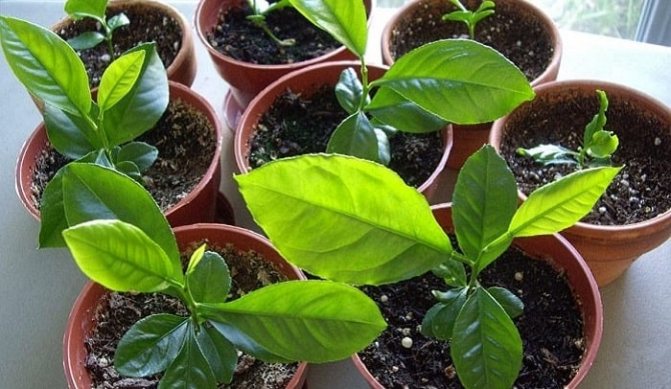

Transplanting young seedlings
The temperature regime is the same - 18-25 ° C; in winter, a decrease to 14 ° C is allowed. Additional lighting required. Insufficient lighting leads to leaf fall and a delay in the onset of fruiting.
Plastic Lemon Pots
Plastic pots for lemons are cheaper than clay pots. They are durable, lightweight, and come in a variety of designs and colors. Plastic pots are durable.
Pros of plastic lemon dish:
- Plants do not grow to the walls of the pots - they are easy to replant;
- The roots do not overheat and do not overcool, since the plastic does not conduct heat well;
- Plastic utensils are easier to disinfect when planting and transplanting lemons.
Cons of plastic pots:
- Plastic walls do not allow water to pass through - there is a risk of moisture stagnation and decay of lemon roots.
- Light pots - tall lemon trees will be unstable, more likely to fall from the wind and jolts of people.
The risk of root rot in indoor lemons in plastic pots can be reduced by using perlite, expanded clay or granite as a drainage layer at the bottom of the container.
Problems, diseases, pests
Many diseases of ornamental lemons are caused by improper care. With a lack of light and nutrients, lemon leaves brighten. Buds and leaves fly around if there is not enough moisture. The dryness of the indoor air is especially difficult for the plant, flowering may stop, the leaves darken and fall off.
Read also: How to make an air tree
Pests also often settle on the plant:
- Scabbards lead to the drying of branches, leaves and the death of the lemon. Remove the pests with a toothbrush and wash the lemon with soapy water.
- The spider mite settles on the wrong side of the leaves and the cobweb gradually envelops the entire tree. Spray with Actelika 0.15% solution three times, every 10 days.
- Mealybug leaves a sticky discharge on the leaves. Fruits and leaves fall off. It is recommended to inspect the plant and collect larvae.
- Citrus aphid. Actelika solution helps to get rid of this pest.
- Thrips and whiteflies also settle on lemons, which must be collected by hand, and the tree must be washed under the shower and treated with soapy water.
Growing indoor lemons, as well as other indoor plants, starts with the problem of choosing the right crockery.Which pot to choose for the future lemon tree: clay, plastic, wood? Where will the lemon be more convenient and grow better?
All three types of pots can be found in stores, they differ in price, workmanship and design, but experts in the cultivation of lemons argue that when choosing a container for planting citrus fruits, one must take into account the material from which the pot is made. It is believed that each material has its own pros and cons. So let's get started!
Some tips for growing lemon
- Experienced flower growers advise to be patient in the first year of lemon flowering and rid the tree of the buds that have appeared. This will help preserve the strength of the tree to produce full fruit for the next season.
- According to gardeners, the eastern side is most suitable for growing lemon in an apartment on a windowsill.
- For the formation of 1 flower, at least 10 viable leaves are needed, therefore, leaf formation should be monitored from a very early age of the seedling.
- In winter, containers filled with water are placed next to the pot. This helps to keep the air humidity at the required level.
- Pruning on all branches is carried out after the appearance of the 5th leaf: in this way, the crown of the tree is formed compact and aesthetically pleasing.
- To increase efficiency, 5 - 8 seeds are buried in the ground, then the strongest shoots are selected.
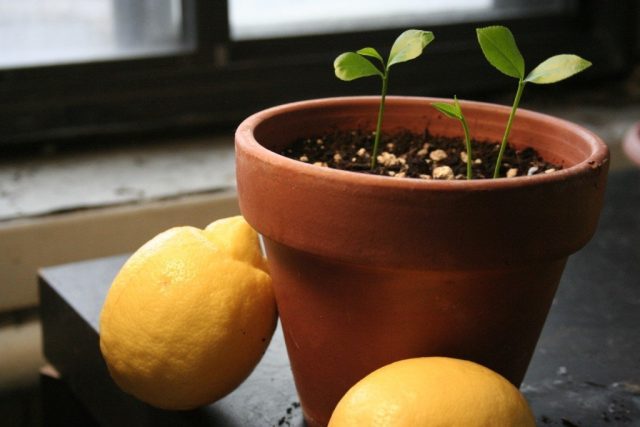

How to get good citrus multiplication rootstocks?
It is desirable to operate in the spring.
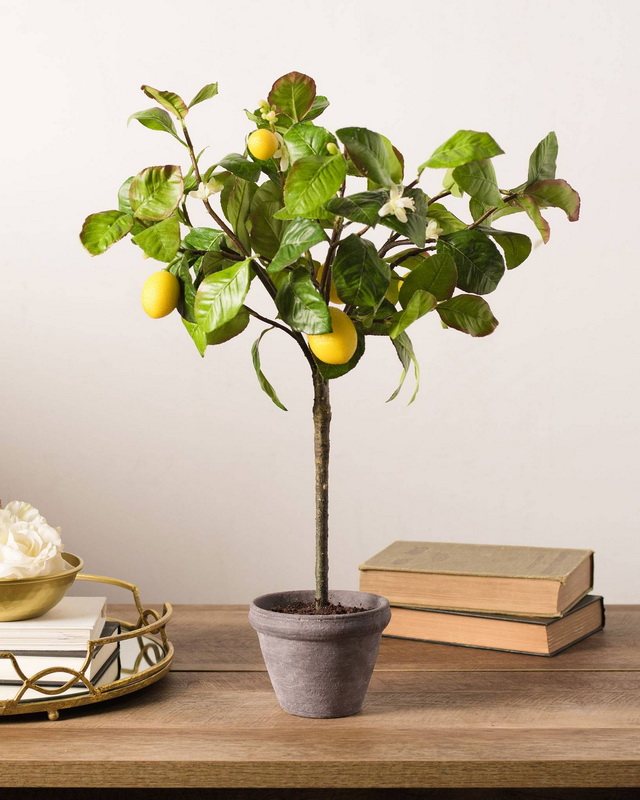

We grow a lemon tree. Illustrations are taken from open sources.
Seed propagation
To test seed for sowing lemons, open the fruit and remove the largest seeds. Soak them overnight in a container of water and remove any that will float to the surface the next day.
Then dry the seeds, place them in an envelope and refrigerate them for 3 weeks, as the lemon seed needs a dormant period that will mimic the cold.
Make seedlings in separate pots with a light, well-drained potting mix.
Cover the seedlings with plastic wrap and place in a bright, warm place.
Shake the cover material every day to remove water (condensation).
Seedlings will appear within 3 weeks after planting.
You will have to be patient, because the tree will take several years before it starts producing lemons.
Lemon seedlings purchased from garden stores
They are planted in soil or in a pot directly. They ripen faster and are less brittle.
Varieties suitable for successful cultivation
For all the time that home gardeners have been trying to get fruit from seed-grown lemon, they have identified the best plant varieties. These included:
Anniversary
Great for home maintenance. With proper care, it bears fruit abundantly.
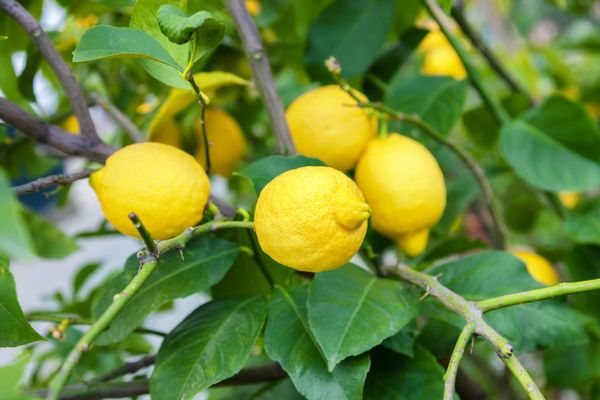

Genoa
A variety specially bred for home cultivation. The tree grows up to 1.5 meters. The fruits are similar in taste to those obtained in natural conditions.


Pavlovsky
Differs in high growth (up to 2 meters) and sweetish taste of fruits. One lemon can weigh up to 500 grams. The scent of the leaves is clearly felt even over a large area.


Ponderosa
The variety is obtained from crossing a lemon and a grapefruit, so its fruits are slightly bitter, they have a lot of seeds. The height of the tree is 1.5 meters. He attracted the attention of gardeners with unpretentiousness and quick response to care.
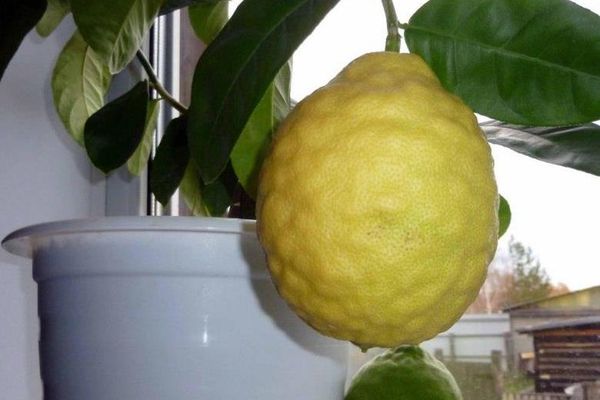

Meyer
Unlike Ponderosa, this lemon-grapefruit hybrid produces sweet and sour fruits. The growth of an adult plant varies from 1.5 to 2 meters. The variety requires a seasonal rest.
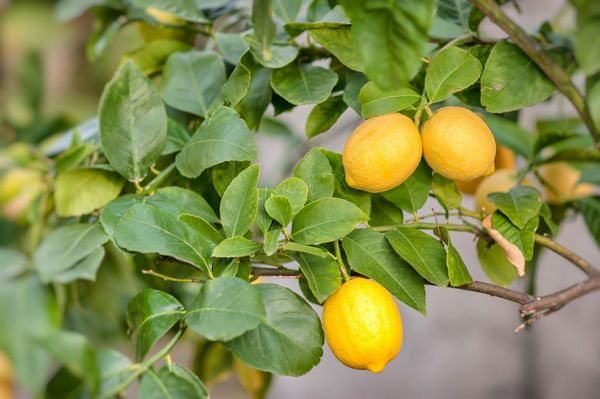

Outdoors
The lemon tree should be placed outside in the sun, as soon as night frosts are no longer feared, and the air temperature is at least 12 degrees, in the fall the plant is returned to the house in a cool but bright room.
The plant does not tolerate windy places, it is installed against the wall or in the inner corner of the house. The Southwest side would be fine for him.
On a note! The lemon tree is very capricious in terms of lighting. It is better not to turn it in different directions to the window and not rearrange it from place to place.
How to grow at home?
Here we will try to figure out how to grow a lemon tree from cuttings and seeds (seeds) at home, is it possible and what methods are there.
From the bone
Variety selection
Homemade lemon is much easier to grow from seed than using cuttings. When propagated by seeds, the plant grows faster, gets sick less, it is unpretentious, it adapts more easily to unfavorable conditions. In order to grow a full-fledged tree at home, it is important to choose the right variety. The following varieties are best suited for home growing:
- Pavlovsky... It has huge fruits weighing up to 500 grams, the taste is sweet, the growth of the tree is over 2 meters, the leaves of the tree exude a wonderful aroma.
- Meyer... This is a hybrid weighing up to 150 grams, taste - sweet and sour, gives a rich harvest.
- Anniversary... It is a bountiful variety. It differs from other varieties in that the skin of the fruit is thick.
- Genoa. The most unpretentious variety, which has a fragrant taste, gives a harvest relatively early - at 4 - 5 years of age.
- Ponderosa... It is a hybrid of grapefruit with lemon with a rather bitter taste, this variety differs from others in that it constantly blooms.
Choose the most suitable fruit, in your opinion, the one you would like to see your crop, or even better, just in case, a couple, for safety net.
Seed preparation
The most important thing is that you cannot use bones that have been extracted for a long time and have time to dry. You need to take fresh, necessarily ripe lemons, carefully remove the seeds from them, wash them with warm water and plant them, and so that the seed germinates faster, you can carefully remove the hard surface of the seed with a sharp knife. If we do not remove the shell, then you need to lower the bones for several hours in a solution of a growth stimulator. The seeds must not be allowed to dry out, they must be planted wet.
Instructions
To germinate a lemon from a seed (seed), it must be planted in a small container, to a depth of 3 centimeters, covered with foil and put in a warm place.
Sprouted young plants up to 15-20 centimeters can develop in containers for sowing, but as they grow, they need to be transplanted into individual pots. When the lemon reaches 30 centimeters in growth, the top must be cut to 20 centimeters, this activates the growth of lateral shoots.
Read about the rules for forming a lemon crown and the secrets of pruning a tree at home here.
Plants from seeds have enviable health, but, like all plants obtained from seeds, they enter fruiting later than those that were grafted with a varietal bud on a seedling.
Watch a video on how to plant a lemon seed correctly:
From the cutting
Cutting a lemon at home is a propagation method in which the qualities of the mother plant are copied, and you will know exactly what kind of fruits will appear on your plant.
On the handle there should be several leaves and 2 or 3 buds on both sides, the length of the cutting is about 10 centimeters.
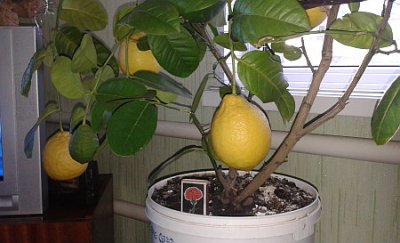

Cuttings you need
place in a solution of Heteroauxin or Kornevit, these are root growth stimulants, and then at the time specified in the instructions for the drug, plant in a pot of soil.
Do not forget to arrange drainage at the bottom of the pot, fragments of ceramic pots, broken, red brick are good for this.
Pour the stalk, cover with a glass jar, and leave for rooting. The bank will exclude excessive evaporation, films, sachets are not very stable, you may not notice the loss of moisture and drying out of the soil.
Rooting is determined by the appearance of growth. Cutting is also a great way to propagate lemon at home.
Gardeners note that lemon is a capricious plant. Plant development is highly dependent on the composition of the soil. The following composition is approximately recommended: 1 part of sand, 1 part of manure, 3 parts of leafy soil and 2 parts of loam. It is advisable to choose a pot from baked clay.
You will find more information on caring for indoor lemon in our material.
Watering
Too good is also not good, we can say about excessive moisture, a regularly overflowed plant will die due to rotting of the root system. Water the lemon as the soil dries., it is important not to forget about timely loosening, which is not in vain called dry irrigation - moisture evaporation after loosening is significantly reduced.
Subtropical plants love spraying, the air humidity during the heating season can be easily regulated by using a container with water. Evaporating, it maintains the microclimate of the room.
You will find more tips for caring for homemade lemon in winter in a separate article, and here we talked about the features of caring for a tree in autumn.
Lighting
The pot with the plant should be placed so that the sun's rays fall on it for less than 3 hours a day.
Top dressing
The ideal option for feeding lemon is the alternation of organic and mineral fertilizers. In winter, it is necessary to reduce the amount of fertilizer, low temperatures have a negative effect on absorption.
Read about how and what to feed indoor lemon at home here.
Growing
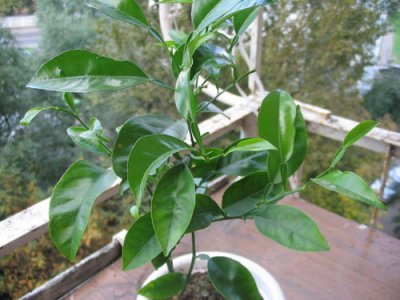

As you grow every spring the lemon needs to be replanted in a pot 5 centimeters more than before, you do not need to plant it in a pot for growth.
There is no need to replant the grown lemon either, every spring the top layer of soil in the container where your tree lives is replaced with humus or fertile garden soil with the addition of humus, and this is enough for him.
Also developed and widely used complex fertilizer Zdraven for citrus fruits, it contains the whole complex of macro and microelements necessary for the growth and fruiting of plants.
Wooden pots and tubs for lemons
The wooden tub is a reward for a lemon for successful long-term growth and development. Indoor lemons are honored to be planted in a wooden tub at a venerable age, when all childhood sores are far behind.
Wooden dishes combine the advantages of earthenware and plastic dishes, but have one drawback - fragility and deformation from moisture.
To protect the tree from moisture, it is painted, impregnated with preservatives, burned over a fire and lined with a film from the inside.
At the bottom of the wooden pot, a drainage layer of gravel, expanded clay or perlite must be laid.
Read also: How to salt mushrooms mushrooms at home
Used wooden pots are treated with lye (ash infusion) before planting again.





